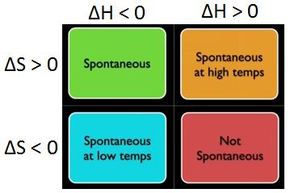Introduction
In a recent post, I introduced a thermodynamic state function called enthalpy and introduced something called Hess’s Law. That post was following up on two previous posts, the first of which covered the 1st and 2nd Laws of Thermodynamics, entropy, and the distinction between state functions vs path functions, and the second of which covered the concepts of work, heat transfer, reversibility, and internal energy in thermodynamic systems.
Just to recap, enthalpy H is a state function that scientists and engineers use to analyze the thermodynamic properties of certain physical processes (particularly chemical reactions). More accurately, it’s the change in this function that we’re most interested in, particularly at constant pressure, which is the case for most biological processes as well as many experimental situations.
You can check out the previous article for the gory details, but the take home message was that the change in enthalpy at constant pressure is equal to the heat transferred to or from the system, and that its status as a state function led to an important general result called Hess’s Law.
The tl; dr version of Hess’s Law is that the change in enthalpy for a reaction is the sum of the enthalpies of formation of the products, each multiplied by its corresponding coefficient (n) from its balanced chemical equation, minus the enthalpies of formation of the reactants, each (again) multiplied by its corresponding coefficient.
Hess’s Law can also be concisely summarized by the following equation which uses sigma (summation) notation:
 (8).
(8).
This is important to scientists and engineers because it has permitted the tabulation of many experimentally-derived ΔH values under a set of standardized conditions.
Adding and subtracting various combinations of these can facilitate convenient thermodynamic predictions for a wide variety of reactions.
The remainder of this article deals with how Hess’s Law is applied and generalized to a variety of physical situations. (more…)


